San Francisco Symphony
Beethoven's Symphony No. 8
Wed, Oct 28, 2009 8:00pm
Davies Symphony Hall
Osmo Vänskä, conductor
Vadim Repin, violin
Aulis Sallinen: Symphony No. 1
Sibelius: Violin Concerto
Beethoven: Coriolan Overture
Beethoven: Symphony No. 8
After the great experience I had last week, I was very glad to make it to Osmo Vänskä’s 2nd program with the SF Symphony. The Sallinen Symphony No. 1 from 1970/71 starts with sustained chords overlaid by tinkling percussion. It immediately made me think it could be the soundtrack to a documentary about the Arctic Circle. I found it pretty, though I was never sure if it was supposed to be going somewhere. My favorite part was a muted viola solo, played by Yun Jie Liu, against slow-moving chords in the violas & 2nd violins.
I remember hearing Vadim Repin when he was a young, hot-shot talent in his 20s, so I was a little startled to see how mature he now looks. His approach to the Sibelius Concerto was consistently serious & inward instead of extroverted. He bowed deep into the strings, creating a continuous, thick sound. Vänskä clearly had other ideas, though, & he led the orchestra in a full-bore romantic interpretation. He certainly made the final movement sound like a dancing bear. The slight tension between the foreground & the background only added to the interest of the performance.
After intermission, Vänskä led a taut, tense & thoroughly thrilling Coriolan Overture. There was a high level of engagement down to the final, soft pizzicatos. When he came back to the podium for the 8th Symphony, he immediately stirred up the sweeping opening bars before we had a chance to stop clapping. He continued in this teasing, humorous vein for the entire symphony. He brought a touch of Rossini to the ending of the scherzo movement. He made Beethoven’s absurdly drawn out final coda exciting & buoyant. The players seemed very involved throughout as well. I enjoyed watching the good communication between the 1st stand cellists. I left feeling that this was a concert I could eagerly hear again.
I Have to Confess
During the very quiet opening of the Silbelius, I hushed a woman next to me who was with her daughter, a girl perhaps 6 years old. Both mother & daughter were quite restless during the Sallinen, whispering to each other & fidgeting. When their act started up while Repin was playing, I had to acknowledge them. I never do such things, & it embarrassed me, but it did quiet them down, until the last movement anyway. & I did say “Thank you” when it was over. I must have scared not only mother & daughter but also the elderly gentleman on my other side, for when I returned after intermission I had vacant seats on both sides.
Intermission
During the intermission I had the additional pleasure of running into some fellow bloggers, including Ced, who hinted that in his recent interview with Repin, the violinist expresses an interesting opinion about yoga.
Thursday, October 29, 2009
SFPL: Marking Time
Marking Time
From September 6 through November 22, 2009
Main Library, Sixth floor, Skylight Gallery
100 Larkin Street (at Grove)
Marking Time is a nice exhibit of book arts on the top floor of the Main Branch Public Library. The books represent the work of the Guild of Book Workers & are in a wide variety of unusual formats.
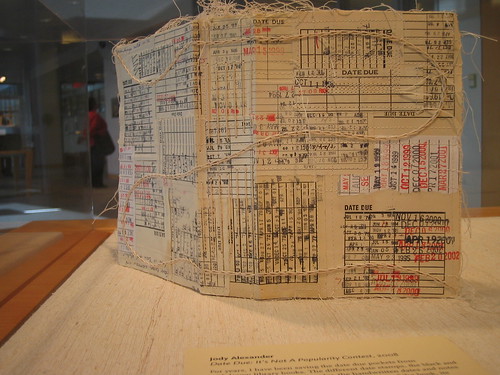
Jody Alexander’s Date Due: It’s Not a Popularity Contest is a collage of due date slips from the pockets of old library books. The artist touchingly claims to feel sorry for the books that weren’t taken out as much.
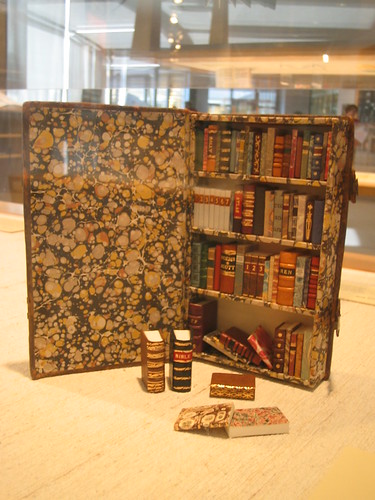
Todd Pattison’s Little Library of miniature books is contained inside an old leather book with clasps.

Susan Collard’s A Short Course in Recollection is a toy book with pages made of wood. Steel balls can run along tracks in the pages when the book is set up. Unfortunately, we do not see it in operation.

Emily Martin’s Siftings demonstrates an unusual sewing technique called “Secret Belgian Binding”. Those crafty Belgians!
I always find these book exhibits both fascinating & infuriating, because one can’t handle the objects or even see the content of most of the books. But they are still very cool. On the same floor, a complimentary exhibit cleverly labeled Masking Time shows how repairs are carried out on damaged books. Warning: A text block torn from its covers is not an easy sight for squeamish book lovers.
From September 6 through November 22, 2009
Main Library, Sixth floor, Skylight Gallery
100 Larkin Street (at Grove)
Marking Time is a nice exhibit of book arts on the top floor of the Main Branch Public Library. The books represent the work of the Guild of Book Workers & are in a wide variety of unusual formats.

Jody Alexander’s Date Due: It’s Not a Popularity Contest is a collage of due date slips from the pockets of old library books. The artist touchingly claims to feel sorry for the books that weren’t taken out as much.

Todd Pattison’s Little Library of miniature books is contained inside an old leather book with clasps.

Susan Collard’s A Short Course in Recollection is a toy book with pages made of wood. Steel balls can run along tracks in the pages when the book is set up. Unfortunately, we do not see it in operation.

Emily Martin’s Siftings demonstrates an unusual sewing technique called “Secret Belgian Binding”. Those crafty Belgians!
I always find these book exhibits both fascinating & infuriating, because one can’t handle the objects or even see the content of most of the books. But they are still very cool. On the same floor, a complimentary exhibit cleverly labeled Masking Time shows how repairs are carried out on damaged books. Warning: A text block torn from its covers is not an easy sight for squeamish book lovers.
SFO: Salome
San Francisco Opera
War Memorial Opera House
Salome
27 Oct 2009 8pm
Salome: Nadja Michael
Herodias: Irina Mishura
Herod: Kim Begley
Jokanaan: Greer Grimsley
Narraboth: Garrett Sorenson
A page: Elizabeth DeShong
First Jew: Beau Gibson
Second Jew: Robert MacNeil
Third Jew: Matthew O’Neill
Fourth Jew: Corey Bix
Fifth Jew: Jeremy Milner
First Soldier: Andrew Funk
Second Soldier: Bojan Knezevic
First Nazarene: Julien Robbins
Second Nazarene: Austin Kness
Cappodocian: Kenneth Kellogg
Slave: Renée Tatum
Conductor: Nicola Luisotti
Director: Seán Curran
As if the on-stage spectacle of Salome isn’t grisly enough, the audience at the opera house is currently greeted by a lobby display containing Jokanaan’s severed head. It’s quite suitable for Halloween, even though Daughter of the Regiment is being presented that evening instead. After having already seen the staging at the dress rehearsal, I took in this performance mostly sitting against the wall in the upstairs standing room. I don’t see anything, but I discovered that even without the staging, this opera is quite disturbing.
I am still impressed by the strong casting in all the roles. Greer Grimsley’s Jokanaan is powerful & full of conviction, whether he is singing on stage or off. Garrett Sorenson as Narraboth & Elizabeth DeShong as the Page both give solid & urgent performances. Kim Begley’s voice is clear & ringing & his Herod appropriately slimy. Irina Mishura’s every utterance as Heroidas was filled with venom, & she was quite scary at moments when she dropped into spitefully declaiming her lines or laughing in mockery. Nadja Michael’s acting is frighteningly convincing, both vocally & physically, though I still have the suspicion that she only approximates a lot of the pitches. She makes a strong sound that is even throughout her range, & I find it in no way harsh or strident.
I also enjoyed being able to focus on the playing of the orchestra. There were many fine moments from the flute, contrabassoon & trumpet. The double bass improved greatly from the dress rehearsal in those sickly harmonics that accompany the execution of Jokanaan. I liked the little slide the violins did in the Dance of the 7 Veils. Luisotti does a good job making all the discordant sections of the music into one continuous, almost impressionistic, flow. A very successful effort all around, of this most sickening of operas.
War Memorial Opera House
Salome
27 Oct 2009 8pm
Salome: Nadja Michael
Herodias: Irina Mishura
Herod: Kim Begley
Jokanaan: Greer Grimsley
Narraboth: Garrett Sorenson
A page: Elizabeth DeShong
First Jew: Beau Gibson
Second Jew: Robert MacNeil
Third Jew: Matthew O’Neill
Fourth Jew: Corey Bix
Fifth Jew: Jeremy Milner
First Soldier: Andrew Funk
Second Soldier: Bojan Knezevic
First Nazarene: Julien Robbins
Second Nazarene: Austin Kness
Cappodocian: Kenneth Kellogg
Slave: Renée Tatum
Conductor: Nicola Luisotti
Director: Seán Curran
As if the on-stage spectacle of Salome isn’t grisly enough, the audience at the opera house is currently greeted by a lobby display containing Jokanaan’s severed head. It’s quite suitable for Halloween, even though Daughter of the Regiment is being presented that evening instead. After having already seen the staging at the dress rehearsal, I took in this performance mostly sitting against the wall in the upstairs standing room. I don’t see anything, but I discovered that even without the staging, this opera is quite disturbing.
I am still impressed by the strong casting in all the roles. Greer Grimsley’s Jokanaan is powerful & full of conviction, whether he is singing on stage or off. Garrett Sorenson as Narraboth & Elizabeth DeShong as the Page both give solid & urgent performances. Kim Begley’s voice is clear & ringing & his Herod appropriately slimy. Irina Mishura’s every utterance as Heroidas was filled with venom, & she was quite scary at moments when she dropped into spitefully declaiming her lines or laughing in mockery. Nadja Michael’s acting is frighteningly convincing, both vocally & physically, though I still have the suspicion that she only approximates a lot of the pitches. She makes a strong sound that is even throughout her range, & I find it in no way harsh or strident.
I also enjoyed being able to focus on the playing of the orchestra. There were many fine moments from the flute, contrabassoon & trumpet. The double bass improved greatly from the dress rehearsal in those sickly harmonics that accompany the execution of Jokanaan. I liked the little slide the violins did in the Dance of the 7 Veils. Luisotti does a good job making all the discordant sections of the music into one continuous, almost impressionistic, flow. A very successful effort all around, of this most sickening of operas.
Friday, October 23, 2009
Vänskä Leads SFS
San Francisco Symphony
Thu, Oct 22, 2009 8:00pm
Davies Symphony Hall
Osmo Vänskä, conductor
Antti Siirala, piano
John Adams, Slonimsky's Earbox
Tchaikovsky, Piano Concerto No. 1
Dvořák, Symphony No. 7
I've enjoyed Osmo Vänskä's conducting before, so I was looking forward to this concert. I did not feel disappointed. John Adam's Slonimsky's Earbox is a loud, frenetic ride using the full resources of the orchestra. It begins with a rapid upward run that is a kind of leitmotif. Vänskä made sure that the orchestra kept up a tense level of energy. Mr. Adams himself was in attendance in box A for the entire evening & took a bow on stage after his piece. This was also my 1st chance to hear new principal viola Jonathan Vinocour, who has a prominent & frantic solo to play.
I'm not sure what to make of Antti Siirala, a replacement for Yundi Li in the Tchaikovsky Piano Concerto. He certainly put in an exceptionally clean performance. I liked his efficient technique & the clarity of his line, even when playing extremely fast. His face remained curiously expressionless the whole time. I did not find him thrilling, & yet his playing was not uninteresting either. The rest of the audience had no doubts about him, though. They applauded after the 1st movement & gave him a standing ovation at the conclusion.
Vänskä is an intense conductor who cues everything. Sometimes one can even hear him grunting. I wonder if this doesn't actually annoy orchestras, but he seems to get results. We got a large-gestured & slightly manic Dvořák 7, with exciting, full climaxes. I especially liked the dance-like 3rd movement, which was a bit edgy & sinister. There were many excellent woodwind solos all evening. I loved the beautiful sounds produced by Timothy Day (flute) & William Bennett (oboe).
Vänskä sticks around next week for an equally splashy program of Sibelius & Beethoven.
Thu, Oct 22, 2009 8:00pm
Davies Symphony Hall
Osmo Vänskä, conductor
Antti Siirala, piano
John Adams, Slonimsky's Earbox
Tchaikovsky, Piano Concerto No. 1
Dvořák, Symphony No. 7
I've enjoyed Osmo Vänskä's conducting before, so I was looking forward to this concert. I did not feel disappointed. John Adam's Slonimsky's Earbox is a loud, frenetic ride using the full resources of the orchestra. It begins with a rapid upward run that is a kind of leitmotif. Vänskä made sure that the orchestra kept up a tense level of energy. Mr. Adams himself was in attendance in box A for the entire evening & took a bow on stage after his piece. This was also my 1st chance to hear new principal viola Jonathan Vinocour, who has a prominent & frantic solo to play.
I'm not sure what to make of Antti Siirala, a replacement for Yundi Li in the Tchaikovsky Piano Concerto. He certainly put in an exceptionally clean performance. I liked his efficient technique & the clarity of his line, even when playing extremely fast. His face remained curiously expressionless the whole time. I did not find him thrilling, & yet his playing was not uninteresting either. The rest of the audience had no doubts about him, though. They applauded after the 1st movement & gave him a standing ovation at the conclusion.
Vänskä is an intense conductor who cues everything. Sometimes one can even hear him grunting. I wonder if this doesn't actually annoy orchestras, but he seems to get results. We got a large-gestured & slightly manic Dvořák 7, with exciting, full climaxes. I especially liked the dance-like 3rd movement, which was a bit edgy & sinister. There were many excellent woodwind solos all evening. I loved the beautiful sounds produced by Timothy Day (flute) & William Bennett (oboe).
Vänskä sticks around next week for an equally splashy program of Sibelius & Beethoven.
The Ives Quartet
Chancellor's Concert Series
Millberry Union Conference Room, 500 Parnassus Avenue
22-Oct-09 12:15pm
The Ives Quartet
Mendelssohn: Quartet in E Minor, Op. 44, No. 2
Quincy Porter: Last movt. of Quartet No. 3
I showed up just a little late, meaning I missed the brief poetry reading that opens these events on the UCSF campus. The Ives Quartet gave a lively performance of Mendelssohn's precocious string quartet & sustained a genuine feeling of excitement in the last movement presto. Before playing the "Song Without Words" 3rd movement, the violist made us laugh by translating Mendelssohn's tempo marking as "Andante, but don't schlep!" ("Dieses Stück darf durchaus nicht schleppend gespielt werden.")
Immediately after the Mendelssohn, someone rushed to present each member of the quartet with a bouquet of flowers, even though they had another number to perform. I've never heard of Quincy Porter, but the group is currently recording all of his quartets. The movement we heard is energetic & has a bold viola part, played with gusto by Jodi Levitz. If this is representative, then Mr. Porter's music is tonal & attractive.
There were about 60 people in attendance, most quite elderly. During the 1st movement of the Mendelssohn, an older gentleman came in, parked his folding shopping cart at the front of the room, then sat in the front row, only to switch sides a minute later. He then periodically unfolded & refolded his program, which clearly bothered the lady sitting next to him.
Millberry Union Conference Room, 500 Parnassus Avenue
22-Oct-09 12:15pm
The Ives Quartet
Mendelssohn: Quartet in E Minor, Op. 44, No. 2
Quincy Porter: Last movt. of Quartet No. 3
I showed up just a little late, meaning I missed the brief poetry reading that opens these events on the UCSF campus. The Ives Quartet gave a lively performance of Mendelssohn's precocious string quartet & sustained a genuine feeling of excitement in the last movement presto. Before playing the "Song Without Words" 3rd movement, the violist made us laugh by translating Mendelssohn's tempo marking as "Andante, but don't schlep!" ("Dieses Stück darf durchaus nicht schleppend gespielt werden.")
Immediately after the Mendelssohn, someone rushed to present each member of the quartet with a bouquet of flowers, even though they had another number to perform. I've never heard of Quincy Porter, but the group is currently recording all of his quartets. The movement we heard is energetic & has a bold viola part, played with gusto by Jodi Levitz. If this is representative, then Mr. Porter's music is tonal & attractive.
There were about 60 people in attendance, most quite elderly. During the 1st movement of the Mendelssohn, an older gentleman came in, parked his folding shopping cart at the front of the room, then sat in the front row, only to switch sides a minute later. He then periodically unfolded & refolded his program, which clearly bothered the lady sitting next to him.
Capitalism: A Love Story
On Wednesday I took in Michael Moore's over-stuffed documentary Capitalism: A Love Story. The film uses the current economic crisis to attack the morality & human cost of the capitalist system. I'm surprised that I haven't read or heard more discussion about this. I mean, here's a movie that plays a swinging version of the Internationale over the closing credits, & it's not ironic! I admired the film's easy access to emotions. It's by turns funny, outraged, despairing & joyous. In other words, it's great entertainment.
Some scenes I found unexpectedly shocking, such as footage of people being removed from their foreclosed homes or Captain Sullenberger testifying to Congress about severe pay cuts for pilots. Ohio congresswoman Marcy Kaptur gives a great forthright interview about the bailout of the financial industry. I was appalled by the unflinching behavior of the many security guards, police & hired goons who protect the faceless wealthy who are the bad guys of the movie. Shots of Lincoln Center & the interior of the Metropolitan Opera House, where I recently spent a lot of time, symbolize the remote lifestyles of the rich.
I saw this at the Century San Francisco Centre Theaters, which has a recession-busting $6 matinee. However, only 6 other people took advantage of it on Wednesday, which made me very self-conscious when I was the only person laughing out loud.
Some scenes I found unexpectedly shocking, such as footage of people being removed from their foreclosed homes or Captain Sullenberger testifying to Congress about severe pay cuts for pilots. Ohio congresswoman Marcy Kaptur gives a great forthright interview about the bailout of the financial industry. I was appalled by the unflinching behavior of the many security guards, police & hired goons who protect the faceless wealthy who are the bad guys of the movie. Shots of Lincoln Center & the interior of the Metropolitan Opera House, where I recently spent a lot of time, symbolize the remote lifestyles of the rich.
I saw this at the Century San Francisco Centre Theaters, which has a recession-busting $6 matinee. However, only 6 other people took advantage of it on Wednesday, which made me very self-conscious when I was the only person laughing out loud.
Wednesday, October 21, 2009
LIEDER ALIVE!
LIEDER ALIVE!
San Francisco Conservatory of Music Concert Hall
Tuesday, October 20, 2009 at 8 p.m.
Eleazar Rodriguez, tenor
John Parr, piano
Ludwig van Beethoven
Adelaide
Robert Schumann
Dichterliebe
-----
Heidi Melton, soprano
John Parr, piano
Johannes Brahms
Wie Melodien
Nicht mehr zu dir zu gehen
An die Nachtigall
Richard Wagner
Wesendonck-Lieder
It was nice to get a substantial hearing of Merola tenor Eleazar Rodriguez, who seemed to have been short-changed on the Merola Grand Finale program. Mr. Eleazar has a beautiful & clean sound, particularly in the middle of his range. He worked hard to sell all the emotions in his songs, though he has such an appealing, good-natured stage presence that I sometimes found it hard to believe in his anguish or anger. He was most convincing in the lighter, sweeter parts of Dichterliebe, such as Wenn ich in deine Augen seh' or Am Leuchtenden Sommergorgen. I imagine him to be quite endearing in an actual opera.
Looking at the program, I realized that this is the 3rd time I've heard Dichterliebe in the past 2 years, & each time John Parr was at the piano. This must be a favorite work of his. At least I hope it is, for his sake!
In the 2nd half of this program, out-going Adler Fellow Heidi Melton was simply marvelous. She came on stage beaming, as if she couldn't be happier to be with us. In the Brahms & Wagner songs she unleashed a full range of emotions, delivered in her rich, large voice. I'm pretty sure that certain notes caused the piano strings to vibrate sympathetically. At times I felt like I was being raised out of my seat. The next step in Ms. Melton's career is taking her to the Deutsche Oper Berlin. I will miss hearing her here.
Before the performance we were encouraged to take a glass of rather sweet wine on the landing outside the hall. Later on someone suggested that this privilege was actually reserved for VIPs, but either this person was mistaken or we were mistaken for our betters.
San Francisco Conservatory of Music Concert Hall
Tuesday, October 20, 2009 at 8 p.m.
Eleazar Rodriguez, tenor
John Parr, piano
Ludwig van Beethoven
Adelaide
Robert Schumann
Dichterliebe
-----
Heidi Melton, soprano
John Parr, piano
Johannes Brahms
Wie Melodien
Nicht mehr zu dir zu gehen
An die Nachtigall
Richard Wagner
Wesendonck-Lieder
It was nice to get a substantial hearing of Merola tenor Eleazar Rodriguez, who seemed to have been short-changed on the Merola Grand Finale program. Mr. Eleazar has a beautiful & clean sound, particularly in the middle of his range. He worked hard to sell all the emotions in his songs, though he has such an appealing, good-natured stage presence that I sometimes found it hard to believe in his anguish or anger. He was most convincing in the lighter, sweeter parts of Dichterliebe, such as Wenn ich in deine Augen seh' or Am Leuchtenden Sommergorgen. I imagine him to be quite endearing in an actual opera.
Looking at the program, I realized that this is the 3rd time I've heard Dichterliebe in the past 2 years, & each time John Parr was at the piano. This must be a favorite work of his. At least I hope it is, for his sake!
In the 2nd half of this program, out-going Adler Fellow Heidi Melton was simply marvelous. She came on stage beaming, as if she couldn't be happier to be with us. In the Brahms & Wagner songs she unleashed a full range of emotions, delivered in her rich, large voice. I'm pretty sure that certain notes caused the piano strings to vibrate sympathetically. At times I felt like I was being raised out of my seat. The next step in Ms. Melton's career is taking her to the Deutsche Oper Berlin. I will miss hearing her here.
Before the performance we were encouraged to take a glass of rather sweet wine on the landing outside the hall. Later on someone suggested that this privilege was actually reserved for VIPs, but either this person was mistaken or we were mistaken for our betters.
Monday, October 19, 2009
APE 2009
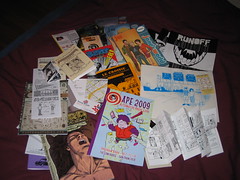 Yesterday I ended up spending more time & money than I expected at the Alternative Press Expo at the Concourse Exhibition Center, starting with the exhorbitantly high $10 entrance fee. There was a lot of very fine print & illustration work. Monsters of various sorts seems to be popular content nowadays. Many of the repeat exhibitors complained that attendance was down from last year, perhaps due to the Treasure Island Music Festival this weekend.
Yesterday I ended up spending more time & money than I expected at the Alternative Press Expo at the Concourse Exhibition Center, starting with the exhorbitantly high $10 entrance fee. There was a lot of very fine print & illustration work. Monsters of various sorts seems to be popular content nowadays. Many of the repeat exhibitors complained that attendance was down from last year, perhaps due to the Treasure Island Music Festival this weekend.I was glad to get re-acquainted with Will Dinski, whose work I remembered seeing at the MoCCA Art Fest a couple of years ago. I like his subtle silk screen graphics. I hope that Nick Mullins has the concluding episodes of his macabre & theatrically-mannered Carnivale ready for next year. Paige Braddock was kind enough to draw me a Jane of my very own. A visit to APE would not be complete without a run-in with the phenomenal Justin Hall, who may have stumbled while trying to spell "pervert" but who flatters me nonetheless. His latest mini-comic about officiating at a same-sex marriage dressed as the Green Lantern is worth twice the price of admission.
Sunday, October 18, 2009
Between the Folds
Between the Folds
SF Doc Fest 2009
Roxie Theater
Sat, Oct 17 4:45 PM
I was surprised by the near-capacity audience that turned out for this film of happy nerds talking about paper folding. Between the Folds is an hour-long documentary by Vanessa Gould about the current explosion of origami as an art form & as a science. It is aimed at a general audience & is comprised of a series of short profiles of origami experts. It also provides tantalizing glimpses of advanced, mind-boggling models by the likes of Robert Lang & Brian Chan. In one stupefying segment, Chris Palmer folds a collapsible flower tower over the course of 3 hours. I found it frustrating not to learn more about how these models were created & why they are significant. I was glad, though, to see old film footage of Akira Yoshizawa, the modern father of origami, reinforcing a crease with a heavy mallet.
Filmmaker Ms. Gould & folders Michael LaFosse & Chris Palmer were on hand to answer questions. Afterward, outside the theater, Mr. LaFosse showed off some of his animal models, & Mr. Palmer recreated his demonstration of the collapsible flower tower as seen in the movie. The film will be repeated tomorrow night at the Roxie.
SF Doc Fest 2009
Roxie Theater
Sat, Oct 17 4:45 PM
I was surprised by the near-capacity audience that turned out for this film of happy nerds talking about paper folding. Between the Folds is an hour-long documentary by Vanessa Gould about the current explosion of origami as an art form & as a science. It is aimed at a general audience & is comprised of a series of short profiles of origami experts. It also provides tantalizing glimpses of advanced, mind-boggling models by the likes of Robert Lang & Brian Chan. In one stupefying segment, Chris Palmer folds a collapsible flower tower over the course of 3 hours. I found it frustrating not to learn more about how these models were created & why they are significant. I was glad, though, to see old film footage of Akira Yoshizawa, the modern father of origami, reinforcing a crease with a heavy mallet.
Filmmaker Ms. Gould & folders Michael LaFosse & Chris Palmer were on hand to answer questions. Afterward, outside the theater, Mr. LaFosse showed off some of his animal models, & Mr. Palmer recreated his demonstration of the collapsible flower tower as seen in the movie. The film will be repeated tomorrow night at the Roxie.
Book Arts Jam
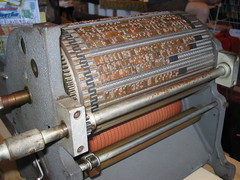 I was down at Foothill College this morning for the Book Arts Jam, an exhibition of hand-made books & printing sponsored by the Bay Area Book Artists. I was delighted to meet again the creator of the whimsical zine All This Is Mine & get the latest issue from her. I handled one of Gay Kraeger's gorgeous watercolor journals with awe. It was on display as a sample of bookbinder Brenda Jatho's wares, yet it was hard to resist the temptation to walk off with it. I also admired Penny Nii's book of Chinese horoscope animals, whose unusual binding opens 3-dimensionally.
I was down at Foothill College this morning for the Book Arts Jam, an exhibition of hand-made books & printing sponsored by the Bay Area Book Artists. I was delighted to meet again the creator of the whimsical zine All This Is Mine & get the latest issue from her. I handled one of Gay Kraeger's gorgeous watercolor journals with awe. It was on display as a sample of bookbinder Brenda Jatho's wares, yet it was hard to resist the temptation to walk off with it. I also admired Penny Nii's book of Chinese horoscope animals, whose unusual binding opens 3-dimensionally.This was my 1st time at this event, & I recognized several exhibitors from Steamroller Prints & Zine Fest. Among both exhibitors & attendees, middle-aged & older women predominated. Are these my new friends if I take up book-making as hobby? I started the bidding in the silent auction for a beautiful collaborative bestiary produced by BABA members. However, my moderate $40 bid was immediately followed by a $100 bid. Where's the fun in that?
Thursday, October 15, 2009
SFO: Salome Dress
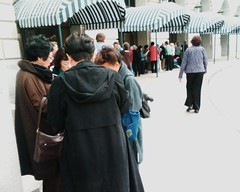
San Francisco Opera
Salome Dress Rehearsal
15 Oct 2009 3pm
Salome: Nadja Michael
Herodias: Irina Mishura
Herod: Kim Begley
Jokanaan: Greer Grimsley
Narraboth: Garrett Sorenson
A page: Elizabeth DeShong
First Jew: Beau Gibson
Second Jew: Robert MacNeil
Third Jew: Matthew O’Neill
Fourth Jew: Corey Bix
Fifth Jew: Jeremy Milner
First Soldier: Andrew Funk
Second Soldier: Bojan Knezevic
First Nazarene: Julien Robbins
Second Nazarene: Austin Kness
Cappodocian: Kenneth Kellogg
Slave: Renée Tatum
Conductor: Nicola Luisotti
Director: Seán Curran
This afternoon I attended a dress rehearsal of SF Opera's Salome, which opens this Sunday afternoon. The set is an abstract, box-like interior. Most of the action takes place on a bright white circle, probably representing the moon. In the back wall is a bank vault door representing the cistern imprisoning Jokanaan. The cast is in modern dress. The soldiers wear sleeveless hoodies. Salome wears a breezy Marilyn Monroe dress.
Even though this was a dress rehearsal, Nadja Michael tackled this triathlon of a role by singing, acting & dancing with complete involvement. I found her acting to be the most compelling aspect of her performance. Her Salome has happily given herself up to an obsession she never questions. Ms. Michael made a consistently strong sound, though I sometimes wondered what pitches she was singing. She did a creditable job dancing, proving herself quite flexible. The choreography eventually presents her nude while simultaneously protecting her modesty. It was clear that Greer Grimsley possesses a huge, weighty voice from the moment we heard him off-stage. Hair in dreadlocks & exposing a broad shirtless chest, he is a virile Jokanaan. I also liked Garrett Sorenson's dark-voiced Narraboth. But really there were no weak links in the cast.
Nicola Luisotti's conducting was unfussy & did not stress orchestral detail or precision. The orchestra's presence was instead cushioned & impressionistic. The opening clarinet run sounded almost casual. Maestro Luisotti reseated the woodwinds to the left, behind the violins. The horns were also on the left, behind the woodwinds. The cellos & double basses were on the right, in front of the rest of the brasses. This may have created a softer, more diffuse brass sound.
This dress rehearsal audience was quite eager & cheered especially Ms. Michael & Mr. Grimsley. The woman behind me seemed to be snacking during the whole performance, as I kept hearing her rustle a plastic bag. I am pretty sure I heard her ask her companion, "Would you like one?" during the climactic Dance of the 7 Veils, as if this bit with the loud music was a bore.
Wednesday, October 14, 2009
SFO: La Fille du Régiment
San Francisco Opera
The Daughter of the Regiment
La Fille du Régiment
Tue Oct 13 2009 8 pm
Marie: Diana Damrau
Tonio: Juan Diego Flórez
Sulpice: Bruno Praticò
The Marquise of Berkenfeld: Meredith Arwady
The Duchess of Krakenthorp: Sheila Nadler
Hortensius: Jake Gardner
Corporal: Kenneth Kellogg
Peasant: Chester Pidduck
Notary: Keith Perry
Conductor: Andriy Yurkevych
Director: Laurent Pelly
I'm glad I returned home in time for the opening night of La Fille du Régiment at SF Opera. I am new to this relentlessly good-humored opera, & I liked how it was presented, with an excellent cast of singers & actors, in a production crammed with silliness. The action takes place on a stage covered with giant maps, & Act I features piles of laundry & underwear on clothes lines.
Meredith Arwady was hilarious as the Marquise, & she used her powerful, chesty low notes to great comic effect. She's handy enough to accompany Ms. Damrau on the piano during the music lesson scene, &, as an added bonus, she interpolated a hearty rendition of love music from Samson & Delilah. Diana Damrau as Marie did laundry with great gusto in Act I & sang all the coloratura beautifully & with great agility. & she could do this even when being held aloft horizontally. I liked her singing most in some of the less flashy moments, however, such as her farewell to the soldiers at the end of the Act I, when she sustained long floating lines.
Dressed in Alpine garb of short pants & suspenders, Juan Diego Florez looked like a little boy in Act I. He has a light, pretty voice which is extremely even. He did not let us down, & sang the 9 high C's in Pour mon âme with absolute security, eliciting shouts of "Bis!" from a gentleman behind me. & as if this were not enough, Mr. Florez gave us yet another sustained high C in the 2nd act. It was all done with such seeming ease that I had the absurd impression that he could go even higher. He also had me clapping for his final entrance atop a MINI Cooper-like tank.
The staging is full of clever comic moments, often nicely integrated with the music. I laughed especially hard in Act II, which opens with a quartet of rather suspect housemaids dusting in time to a tedious minuet. The minuet is hilariously reprised later to accompany the entrance of the chorus as an army of doddering, elderly, near-sighted wedding guests. They looked a bit too much like an opera audience promenading to the bar at intermission.
The Daughter of the Regiment
La Fille du Régiment
Tue Oct 13 2009 8 pm
Marie: Diana Damrau
Tonio: Juan Diego Flórez
Sulpice: Bruno Praticò
The Marquise of Berkenfeld: Meredith Arwady
The Duchess of Krakenthorp: Sheila Nadler
Hortensius: Jake Gardner
Corporal: Kenneth Kellogg
Peasant: Chester Pidduck
Notary: Keith Perry
Conductor: Andriy Yurkevych
Director: Laurent Pelly
I'm glad I returned home in time for the opening night of La Fille du Régiment at SF Opera. I am new to this relentlessly good-humored opera, & I liked how it was presented, with an excellent cast of singers & actors, in a production crammed with silliness. The action takes place on a stage covered with giant maps, & Act I features piles of laundry & underwear on clothes lines.
Meredith Arwady was hilarious as the Marquise, & she used her powerful, chesty low notes to great comic effect. She's handy enough to accompany Ms. Damrau on the piano during the music lesson scene, &, as an added bonus, she interpolated a hearty rendition of love music from Samson & Delilah. Diana Damrau as Marie did laundry with great gusto in Act I & sang all the coloratura beautifully & with great agility. & she could do this even when being held aloft horizontally. I liked her singing most in some of the less flashy moments, however, such as her farewell to the soldiers at the end of the Act I, when she sustained long floating lines.
Dressed in Alpine garb of short pants & suspenders, Juan Diego Florez looked like a little boy in Act I. He has a light, pretty voice which is extremely even. He did not let us down, & sang the 9 high C's in Pour mon âme with absolute security, eliciting shouts of "Bis!" from a gentleman behind me. & as if this were not enough, Mr. Florez gave us yet another sustained high C in the 2nd act. It was all done with such seeming ease that I had the absurd impression that he could go even higher. He also had me clapping for his final entrance atop a MINI Cooper-like tank.
The staging is full of clever comic moments, often nicely integrated with the music. I laughed especially hard in Act II, which opens with a quartet of rather suspect housemaids dusting in time to a tedious minuet. The minuet is hilariously reprised later to accompany the entrance of the chorus as an army of doddering, elderly, near-sighted wedding guests. They looked a bit too much like an opera audience promenading to the bar at intermission.
Monday, October 12, 2009
MAD: Slash
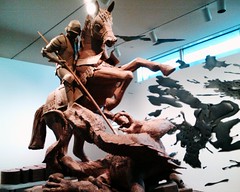 Museum of Arts & Design
Museum of Arts & DesignSlash: Paper Under The Knife
October 7, 2009 - April 4, 2010
Read My Pins: The Madeleine Albright Collection
September 30, 2009 - January 31, 2010
Sunday was my last full day in New York, & the only thing I cared to do was take a pleasant stroll in Central Park. But this being New York, I also ran into a parade on 5th Avenue, & then I was lured into the Museum of Arts & Design's new building, which seemed to be saying "HI" to me.
As advertised, the exhibit Slash: Paper Under The Knife featured a lot of elaborate paper cuttings & books with things cut out of them. My favorite work, however, was Chris Gilmour's The Triumph of Good & Evil, a large sculpture of St. George slaying the dragon, all made from cardboard boxes. It's probably 5 feet high & has incredible detail, down to individual scales on the dragon.
I also liked Oliver Herring's life-size sculpture of Alex, a young fellow with tattoos & surgical scars. The artist took photographs of every surface of the subject's body, cut the pictures into shard-like shapes, then pasted them onto a Styrofoam core. The colors are not true to life but instead are bright greens, blues, reds, oranges & yellows. Alex's short haircut is naturalistically represented by thin strips of shredded paper. The effect is simultaneously realistic & abstract, & it is definitely a bit freaky.
Several of the pieces are still being installed, & in at least one case an artist was busily working on a piece right in the gallery. I suppose this is what happens when you turn in your homework late.
On the 2nd floor I discovered a baffling display of large pins worn by Madeleine Albright in her official capacity as Secretary of State. These pins are enormous pieces of jewelry, in often insinuating animal shapes. Butterflies, spiders, & stinging insects seems to be well-represented.
Sunday, October 11, 2009
The Hispanic Society of America
Yesterday afternoon I journeyed to Washington Heights to visit The Hispanic Society of America. It sits in a complex of buildings designed in the classical style & decorated with bizarre over-sized statues. The museum is a bit decrepit, & they obviously haven't had resources to update the exhibits for decades. The collection ranges from Neolithic bronzes to a decorative charger from the 1920's with a flapper girl painted on it. But the core of the collection comes from 17th century Spain, & I was shocked to discover myself at the feet of Goya's imperious & bold Duchess of Alba. My museum companion thought she could be Carmen's sister. Upstairs were more Goya & excellent samples of El Greco & Velázquez. I was especially taken by Velázquez's warm Portrait of a Little Girl, with her wary & intelligent look. Unfortunately the viewing conditions in the upstairs gallery are less than ideal, & it is impossible to find a good place to stand to view the finest paintings.
I also marveled at an exquisite Silver Filigree Casket from 17th century Goa. I can't imagine that there is much jewelry worthy to be stored in such a thing. Most surprising of all is that I & my companion were the only visitors the whole time we were there. So it is actually possible to go someplace in New York that is not swamped with people. I'm sure the Duchess of Alba would love to have more visitors.
I also marveled at an exquisite Silver Filigree Casket from 17th century Goa. I can't imagine that there is much jewelry worthy to be stored in such a thing. Most surprising of all is that I & my companion were the only visitors the whole time we were there. So it is actually possible to go someplace in New York that is not swamped with people. I'm sure the Duchess of Alba would love to have more visitors.
Milkmaid at the Met Museum
 Friday morning began with rain, so I, along with thousands of others, herded into the Metropolitan Museum of Art. I find the Met both deeply inspiring & just plain exhausting. I've been visiting since I was a kid, but I've only seen a few parts of the collection. & every time I come back, the museum seems to have gotten bigger!
Friday morning began with rain, so I, along with thousands of others, herded into the Metropolitan Museum of Art. I find the Met both deeply inspiring & just plain exhausting. I've been visiting since I was a kid, but I've only seen a few parts of the collection. & every time I come back, the museum seems to have gotten bigger!This day I decided to let someone else keep me focused, so I joined a couple of docent-led tours. In the morning I viewed the Ancient Near Eastern Art gallery with an over-eager group of visitors, including an English couple & an eccentric older gentleman with a German accent. When the docent suggested that a lovely pendant figure of a goat depicted the animal dead, the German fellow remained skeptical & thought we should all vote as to whether the animal was supposed to be dead or alive.
After a late afternoon coffee in the American Wing Courtyard, I visited the small exhibit highlighting Vermeer's Milkmaid, generously on loan from the Rijksmuseum. It is brought together with the 5 other Vermeers owned by the Met. Even surrounded by its peers, it stands out glowingly. The painting is small, & one has to jockey continually for a position closer to it. The rich blue of the apron & the red of the dress are quite unlike any of the reproductions. I enjoyed being able to discern details like the tan line on the woman's forearm & the yellow edge of her rolled-up sleeve. The only thing I was unclear about is the white shape between her foreshortened right arm, the pitcher & her blue apron. Perhaps it is a dishcloth.
The Milkmaid is supplemented by additional images & commentary to support the curator's theory that the painting is not simply about domestic virtue, but also suggests the sexual availability of the kitchen maid.
The museum is open late on weekends, & the balcony above the Great Hall was turned into a cocktail lounge, complete with a small salon band. I was amused to find something called a "Clearance Shop" inside the museum. No art works were being deaccessioned at bargain prices. Instead, they stocked the first Christmas items I've seen for sale this year.
Saturday, October 10, 2009
Met: Barbiere
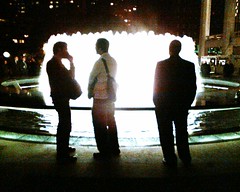
Il Barbiere di Siviglia
The Metropolitan Opera
Thursday, October 8, 2009, 8:00 pm
Conductor: Maurizio Benini
Rosina: Joyce DiDonato
Count Almaviva: Barry Banks
Figaro: Rodion Pogossov
Dr. Bartolo: John Del Carlo
Don Basilio: Orlin Anastassov
Berta: Claudio Waite
Ambrogio: Rob Besserer
Production: Bartlett Sher
I was able to be in a comfy seat in the Grand Tier this evening, & therefore had an excellent view for this cartoonish & silly production of Il Barbiere di Siviglia. The stage is extended around & in front of the pit, so that singers can walk right up to the 1st row of the auditorium. The set consists primarily of doors which are rearranged for every scene. Everything on stage is in motion at some point. Even Figaro's barber shop is a huge wagon, pulled by several women & followed by a very sweet live donkey.
The production is full of outrageous gags, many of which took me by surprise. Even a giant anvil descending slowly from the flys during the Act I finale somehow worked. Poor Ambrogio takes a lot of physical abuse, being stepped on, crushed by a tree & even blown up.
John Del Carlo as Dr. Bartolo not only sang with a large, resonant voice but also created a great character. His Bartolo was funny & yet always remained a serious obstacle to the lovers. Joyce DiDonata has a delightfully ingratiating stage presence. Her voice easily executes long, even lines, & she applied liberal ornamentation.
Rodion Pogossov made Figaro a likeably self-confident fellow, & he kept up an extremely rapid tempo for Largo al factotum. During his curtain call, it look liked Figaro gave out business cards to people in the front row. Barry Banks has a very high & light voice, & he negotiates Almaviva's long lines fearlessly, though his coloratura is sometimes a little blurry. He sang all of the Count's final bravura aria, Cessa di più resistere. I may never have heard the whole thing in a theater before.
I found Maurizio Benini's conducting to be relentless fast, but no one seemed to have any problems keeping up. The musicians in the Met's pit continue to astonish me. The guitarist accompanying the Count's two serenades in the 1st scene played with great beauty & finesse. If someone played the guitar like that for me, I'd fall for it.
Friday, October 09, 2009
High Line Park
 High Line Park is another of those attractions that people keep mentioning. Yesterday morning just before noon I took a walk along this fragment of elevated train tracks turned into an urban park. It's 3 stories up, so one gets unusual views of the surrounding architecture, the river & billboards, which are now at eye-level. It's definitely more urban than park. There is an observation deck of sort, designed explicitly for viewing the traffic below. The planted areas are made to look wild, but they are contained & clearly delineated, more like decorations for the walkways. There is plenty of seating, & even a coffee stand & restrooms midway down the path. Lots of people, with cameras in hand, were promenading on this windy morning.
High Line Park is another of those attractions that people keep mentioning. Yesterday morning just before noon I took a walk along this fragment of elevated train tracks turned into an urban park. It's 3 stories up, so one gets unusual views of the surrounding architecture, the river & billboards, which are now at eye-level. It's definitely more urban than park. There is an observation deck of sort, designed explicitly for viewing the traffic below. The planted areas are made to look wild, but they are contained & clearly delineated, more like decorations for the walkways. There is plenty of seating, & even a coffee stand & restrooms midway down the path. Lots of people, with cameras in hand, were promenading on this windy morning.For lunch, I had take-out sushi from Chelsea Market, an over-crowded gourmet food mall right beneath the park. The overcrowding may have been due to preparations for the New York City Wind & Food Festival opening that night.
Thursday, October 08, 2009
Hamlet on Broadway

Hamlet on Broadway
Donmar Warehouse production of Hamlet
at the Broadhurst Theatre
7 October 2009, 7:30pm
Ross Armstrong (Cornelius)
Harry Attwell (Guildenstern)
Ron Cook (Polonius, Gravedigger)
Ian Drysdale (Osric)
Peter Eyre (Ghost of Hamlet's Father, Player King)
Michael Hadley (Barnardo, Priest, Captain)
Colin Haigh (Member of the Court)
Sean Jackson (Reynaldo)
Geraldine James (Gertrude)
James Le Feuvre (Member of the Court)
Gwilym Lee (Laertes)
Jenny Funnell (Player Queen)
Jude Law (Hamlet)
John MacMillan (Rosencrantz)
Gugu Mbatha-Raw (Ophelia)
Kevin R. McNally (Claudius)
Henry Pettigrew (Marcellus, Gravedigger, English Ambassador)
Matt Ryan (Horatio)
Alan Turkington (Fortinbras, Francisco, Player)
Faye Winter (Member of the Court)
Michael Grandage (Director)
This Broadway production of Hamlet opens with Jude Law crouching on a darkened stage as ominous music rumbles through the theater. The action that follows takes place in an empty interior with high marble walls. 2 massive sliding doors in the back can open to reveal a shallow exterior space. The cast is in modern dress & mostly in black, of course. In one of the production's few scenic effects, snow falls on Hamlet as he recites "To be, or not to be?"
Jude Law's Hamlet is dominated by the emotion of disgust, & Mr. Law communicates this well, though he displays a limited emotional range otherwise. He does cut a trim & attractive figure on stage & shows occasional flashes of amusing mime, as when imitating the walk of a crab or an ape. His best piece of business was when he moved apart the chairs set up for Claudius & Gertrude in the play scene. The rest of the cast was a mixed bag, though I liked Kevin R. McNally's unflappable Claudius, with a speech pattern reminiscent of a British Prime Minister. I also liked the simple presence of Geraldine James as Gertrude.
The production itself is rather tame & without distinctive moments. I was dismayed that Laertes's followers are dropped entirely from IV.v. Instead, Laertes simply walks into the scene as if he just happened to be passing by. I was also upset that we lost half of Gertrude's narration of the drowning of Ophelia. They also truncated a favorite speech of mine, when Hamlet admonishes Polonius, "Use every man after his own desert, & who shall 'scape whipping?"
There was a only one intermission, taken after III.i. This meant that the 2nd half was an endurance test at over an hour & a half long. I think we all would have benefited from a 2nd intermission, & I was impressed by how well-disposed the audience was despite the static staging. The seats around me were populated mostly with teenage girls. A pre-curtain announcement requested the audience to "refrain from texting during the performance." The young lady next to me periodically checked her mobile phone anyway.
Wednesday, October 07, 2009
Met: Tosca
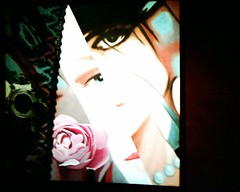
Tosca
The Metropolitan Opera
Tuesday, October 6, 2009, 8:00 pm
Conductor: Joseph Colaneri
Tosca: Karita Mattila
Cavaradossi: Marcelo Álvarez
Scarpia: George Gagnidze
Sacristan: Paul Plishka
Angelotti: David Pittsinger
Spoletta: Joel Sorensen
Sciarrone: James Courtney
Shepherd: Jonathan Makepeace
Jailer: Keith Miller
Production: Luc Bondy
Set Designer: Richard Peduzzi
Everyone here is talking about the Met's new Tosca, & I attended expecting a scandal, complete with outraged booing. Instead I found an audience cheering for the principals & a drab modern setting that looks like Fascist Italy. Act II took the most liberties with the text. Scarpia has 3 whores lounging around his office. Tosca stabs him closer to the groin than the heart. There's no crucifix or candles. Instead Tosca retrieves the Attavanti fan then languidly reclines on a sofa. We never see her leave the room. I think the idea is to expunge the religiosity of the story. But talk of God & the Modonna is all over the place, & the libretto makes a clear contrast between Tosca's piety & Cavaradossi's atheism, so I think the approach is incorrect.
There are surprises at the end of each of each act, however, & the magic-show ending, with Tosca seen frozen at the top of her fall, elicited a genuine gasp from the audience. But what really kept me focused during the evening were the performances of all 3 principals & the gorgeous playing of the Met orchestra. Karita Matilla's voice & stage presence are thrilling. There's a physicality & strength to everything she does, & she seems able to sing in any position, even when Scarpia looks like he's bending her over enough to break her back. Her Vissi d'arte is more disbelieving & angry than traditionally sorrowful & pathetic. She also does great stage gasps, screams & breakdowns.
Marcelo Álvarez as Cavaradossi had dependable high notes that were strong & bright, & he was convincingly fearless in Act II. His E lucevan le stelle was plaintive & low-key rather than brilliant. George Gagnidze was appropriately menacing & heavy as Scarpia. Scarpias in 18th century garb sometimes come across as foppish. Not so this thoroughly modern version.
TV cameras were quite visible all over the auditorium, especially one on a crane extending from a box. It was probably a rehearsal for an up-coming broadcast. Poor Spoletta tripped on stairs in both Act II & Act III. I hope he recovers his footing for the actual broadcast.
Tuesday, October 06, 2009
Met Rush Tickets
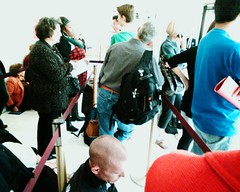 By the generosity of the Agnes Varis and Karl Leichtman Rush Tickets program, I will sit in the orchestra for tonight's Tosca at the Met for a mere $20. Ticket sales start 2 hours before curtain, & I was advised to join the line by 3:30pm for the 6pm sales time, which I did. I was about number 40 in line. The line starts downstairs & winds through an underground parking garage. However, people complained about fumes from on-going construction, so the management moved us upstairs at around 4:30pm. By 5:30pm the line was quite long, & I wonder if everyone in it was able to get a rush ticket. Once the sales started, things moved very quickly, & I was back in the plaza with ticket in hand within 3 minutes. Seniors are permitted to reserve rush tickets by phone, so they do not have to stand in line. This is most considerate.
By the generosity of the Agnes Varis and Karl Leichtman Rush Tickets program, I will sit in the orchestra for tonight's Tosca at the Met for a mere $20. Ticket sales start 2 hours before curtain, & I was advised to join the line by 3:30pm for the 6pm sales time, which I did. I was about number 40 in line. The line starts downstairs & winds through an underground parking garage. However, people complained about fumes from on-going construction, so the management moved us upstairs at around 4:30pm. By 5:30pm the line was quite long, & I wonder if everyone in it was able to get a rush ticket. Once the sales started, things moved very quickly, & I was back in the plaza with ticket in hand within 3 minutes. Seniors are permitted to reserve rush tickets by phone, so they do not have to stand in line. This is most considerate.This is for the controversial Luc Bondy production, & I hope to hear some booing.
Monday, October 05, 2009
Kandinsky at the Guggenheim
Solomon R. Guggenheim Museum
Kandinsky
Since I had such a short visit to the Neue Galerie in the morning, I thought I would have plenty of time to take in the Guggenheim, which is just a few blocks away. I got sucked into their massive Kandinsky survey, & it totally wore me down. Not only is the entire spiral filled with paintings from all periods of his career, but there was another gallery filled with works on paper, as well as an historical survey of photographs of him & his wife. The free audio tour emphasizes Kandinsky's interest in the synesthetic connection between painting & music. It includes excerpts of Schoenberg to listen to while looking at the pictures.
I liked what I saw, but it was too much of a good thing. It also made me realize that I've been seeing Kandinsky rip-offs everywhere without knowing it. A surprisingly large number of works in the show are from the Guggenheim itself.
The permanent collection has a favorite painting, though: Picasso's alarmingly precocious Le Moulin de la Galette, done when the artist was 19.
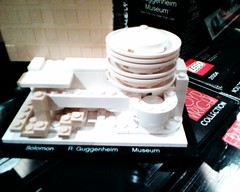 For some reason I didn't like any of the picture postcards of the building. Instead, my favorite gift shop item was this Lego set version of the museum.
For some reason I didn't like any of the picture postcards of the building. Instead, my favorite gift shop item was this Lego set version of the museum.
Kandinsky
Since I had such a short visit to the Neue Galerie in the morning, I thought I would have plenty of time to take in the Guggenheim, which is just a few blocks away. I got sucked into their massive Kandinsky survey, & it totally wore me down. Not only is the entire spiral filled with paintings from all periods of his career, but there was another gallery filled with works on paper, as well as an historical survey of photographs of him & his wife. The free audio tour emphasizes Kandinsky's interest in the synesthetic connection between painting & music. It includes excerpts of Schoenberg to listen to while looking at the pictures.
I liked what I saw, but it was too much of a good thing. It also made me realize that I've been seeing Kandinsky rip-offs everywhere without knowing it. A surprisingly large number of works in the show are from the Guggenheim itself.
The permanent collection has a favorite painting, though: Picasso's alarmingly precocious Le Moulin de la Galette, done when the artist was 19.
 For some reason I didn't like any of the picture postcards of the building. Instead, my favorite gift shop item was this Lego set version of the museum.
For some reason I didn't like any of the picture postcards of the building. Instead, my favorite gift shop item was this Lego set version of the museum.
Neue Galerie
After a pleasant walk cross-town through Central Park, I made it for the last day of the Oskar Kokoschka show at the Neue Galerie. This museum is elegant but quite small, & the 3rd floor was closed due to the hanging of a new exhibit, making it even smaller. Kokoschka is represented by half a dozen portraits, the sitters looking fretful at best, & a selection of drawings, water color studies & prints. I was amused by the colored drawing Die christliche Liebe (Alma Mahler und der Künstler). The 2 figures are walking in a garden. Alma is a large, pear-shaped figure in a blue dress, & the artist represents himself as an undersized, child-like figure in a red outfit walking beside her. His outstretched hand directs the viewer to a couple kissing in the bushes.
I can't say that I have much of an eye for Klimt, but the room of his decorative square canvases, featuring the portrait of Adele Bloch-Bauer I, is admittedly stunning & worth the price admission.
Also striking is the period furniture sitting in the corners of the gallery. I liked the large Koloman Moser collector's cabinet with its oak veneer stained black but with the grain pattern chalked white. The scroll-like "Knieschwimmer" club chair by Adolf Loos generated much discussion among the visitors, as we tried to figure out if it could be made comfortable. We decided that the chair must have had a separate foot rest which is now missing.
For the full experience, I had lunch in the pricey, Viennese-themed restaurant, Cafe Sabarsky. This seems to be an attraction of its own. There was a line to get in, though I could be seated immediately if I was willing to share a table. As a result, I had a delightful conversation with a woman from Mississippi who once did standing room at the San Francisco Opera to hear Beverly Sills in Traviata.
I can't say that I have much of an eye for Klimt, but the room of his decorative square canvases, featuring the portrait of Adele Bloch-Bauer I, is admittedly stunning & worth the price admission.
Also striking is the period furniture sitting in the corners of the gallery. I liked the large Koloman Moser collector's cabinet with its oak veneer stained black but with the grain pattern chalked white. The scroll-like "Knieschwimmer" club chair by Adolf Loos generated much discussion among the visitors, as we tried to figure out if it could be made comfortable. We decided that the chair must have had a separate foot rest which is now missing.
For the full experience, I had lunch in the pricey, Viennese-themed restaurant, Cafe Sabarsky. This seems to be an attraction of its own. There was a line to get in, though I could be seated immediately if I was willing to share a table. As a result, I had a delightful conversation with a woman from Mississippi who once did standing room at the San Francisco Opera to hear Beverly Sills in Traviata.
Sunday, October 04, 2009
Safety Last! at Loew's Jersey
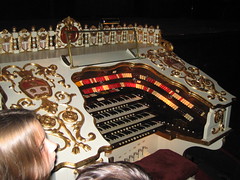 Safety Last! (1923)
Safety Last! (1923)The Landmark Loew's Jersey - Jersey City
Sat, Oct 3, 2009 8:00 pm
Silent, shown with LIVE ORGAN accompaniment by
Ralph Ringstad, Jr. on the Loew’s Wonder Morton
To see Harold Lloyd's Safety Last! in an original 1920's movie palace with organ accompaniment, I suppose I did something most New Yorkers almost never do: travel to New Jersey. Loew's Jersey is an opulent & cavernous theater, vaster than the Castro Theatre in San Francisco. The lobby, with promenade areas on 2 levels, is quite spacious. The building, however is falling apart & in urgent need of restoration. It does have a kind of decaying grandeur, however. A devoted community of volunteers, including those in the projection booth, are keeping it alive.
Ralph Ringstad, Jr accompanied the film on a powerful Morton theater organ, the only one in such a space in the Metropolitan Area. At dramatic moments, Mr. Ringstad vamped on a steadily repeating chord, a trick that made me think of Philip Glass.
This would be a hard theater to fill, but there was a good turn out, & the audience was happy & really got into the picture. They applauded the iconic moment when Harold dangles from the clock hands. Because of the simplicity of its scenario & the wealth of inventive gags, the movie still entertains. The few children in the audience could be heard laughing throughout. The movie ends with a clever but curiously irrelevant gag in which Harold loses his shoes & socks in a sticky puddle.
Saturday, October 03, 2009
NY Art Book Fair
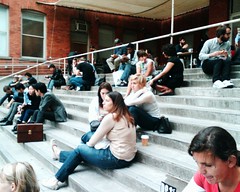 NY Art Book Fair
NY Art Book FairP.S.1 Contemporary Art Center, Long Island City, Queens
The NY Art Book Fair was large & crowded, & the attendees youthful, artsy & attractive. I think I found where the hipsters are. The book fair takes up at least 2 floors of P.S.1, & there was just a little too much for me to take in. The offerings could be anything from a soft-porn zine called For Lonely Adults Only to elaborate & expensive art books, such as the 25-volume One Billion Dots. All the exhibitors were quite friendly & allowed me to handle some very fancy books, many of them hand-made
There's also a fun installation inside P.S.1 that makes it look like visitors are walking on the bottom of a swimming pool filled with water. The Art Center has a ludicrously inefficient cafe. I cannot imagine how it took over 15 minutes for them to make a sandwich whose only ingredients were bread, turkey & melted cheese.
GEMS at LPR
The GEMS Project at Le Poisson Rouge
Friday, October 2 at 6:30 pm
Ensemble Viscera
Brooklyn Baroque
New York Baroque Dance Company
This was the last evening in a series of early music programs sponsored by the Gotham Early Music Scene. 3 groups each did a 30 minute set for an audience of largely older patrons, not unlike your average opera or symphony audience. I guess it's still hard to bring out the younger audience for classical music, even to such a hip venue.
The 5-member Ensemble Viscera, accompanying themselves on lutes & guitars, sang a set of Jácara, 17th century Spanish ballads about criminals & whores. Their delivery was pretty & surprisingly tame given the subject matter. Translations & pictures from the period were projected behind them. I liked the refrain "Anyone who sings is a singing rat" that occured in their 1st & last numbers. Nell Snaidas, singing of a woman confessing her sins of love, created an operatic scene in miniature.
Brooklyn Baroque, a trio of Baroque flute, harpsichord & cello, performed flute sonatas by Telemann, Bach & Joseph Bodin de Boismortier. Flutist Andrew Bolotowsky has a very clean, pleasant flute sound with no breathiness in it at all. Their playing is easy to listen to, though lacking in dynamic contrast.
In the last set, dancers Catherine Turocy and Carlos Fittante, in full 17th century court regalia, played out strange courtship rituals with plenty of flourishes of capes, fans & swords. They were accompanied by a violin, harpsichord & modern flute playing French period music. They wore expressionless face masks for their dance to Les Folies, & I found it a bit freaky. Perhaps it was post-modern Baroque.
I had an ideal viewing position, perched atop a bar stool at the edge of the table seating area. For some reason I also got more attentive service than when I was in preferred seating on Tuesday & as a consequence was able to imbibe an extra drink or two, along with a small plate of bratwurst, sauerkraut & bretzel. I can see how LPR could be dangerously addictive.
Friday, October 2 at 6:30 pm
Ensemble Viscera
Brooklyn Baroque
New York Baroque Dance Company
This was the last evening in a series of early music programs sponsored by the Gotham Early Music Scene. 3 groups each did a 30 minute set for an audience of largely older patrons, not unlike your average opera or symphony audience. I guess it's still hard to bring out the younger audience for classical music, even to such a hip venue.
The 5-member Ensemble Viscera, accompanying themselves on lutes & guitars, sang a set of Jácara, 17th century Spanish ballads about criminals & whores. Their delivery was pretty & surprisingly tame given the subject matter. Translations & pictures from the period were projected behind them. I liked the refrain "Anyone who sings is a singing rat" that occured in their 1st & last numbers. Nell Snaidas, singing of a woman confessing her sins of love, created an operatic scene in miniature.
Brooklyn Baroque, a trio of Baroque flute, harpsichord & cello, performed flute sonatas by Telemann, Bach & Joseph Bodin de Boismortier. Flutist Andrew Bolotowsky has a very clean, pleasant flute sound with no breathiness in it at all. Their playing is easy to listen to, though lacking in dynamic contrast.
In the last set, dancers Catherine Turocy and Carlos Fittante, in full 17th century court regalia, played out strange courtship rituals with plenty of flourishes of capes, fans & swords. They were accompanied by a violin, harpsichord & modern flute playing French period music. They wore expressionless face masks for their dance to Les Folies, & I found it a bit freaky. Perhaps it was post-modern Baroque.
I had an ideal viewing position, perched atop a bar stool at the edge of the table seating area. For some reason I also got more attentive service than when I was in preferred seating on Tuesday & as a consequence was able to imbibe an extra drink or two, along with a small plate of bratwurst, sauerkraut & bretzel. I can see how LPR could be dangerously addictive.
Friday, October 02, 2009
Met: Le Nozze di Figaro

Le Nozze di Figaro
Metropolitan Opera
Thursday, October 1, 2009, 8:00 pm
Conductor: Dan Ettinger
Countess Almaviva: Emma Bell
Susanna: Danielle de Niese
Cherubino: Isabel Leonard
Count Almaviva: Bo Skovhus
Figaro: John Relyea
Don Bartolo: Maurizio Muraro
Marcellina: Wendy White
Don Basilio: Philip Langridge
Antonio: Patrick Carifizzi
Don Curzio: Ton Stevenson
Barbarina: Ashley Emerson
Production: Jonathan Miller
I had never heard of conductor Dan Ettinger before, & I found him quite impressive. He led with varied & flexible tempos & seemed to have ideas for nearly every bar of the score, starting with the Overture, which had some careful dynamic contrasts. He conducted with a closed score for most of the evening, which seems both risky & a bit cocky.
As last night, the cast was remarkably uniform & of a high level. With both John Relyea & Bo Skovhus, we had 2 manly baritones on stage. Mr. Relyea was a bundle of energy & intelligence, while Mr. Skovhus looks the part of a successful seducer, even though he was constantly being foiled throughout the evening. Emma Bell's majestic soprano contrasted effectively with Danielle de Niese's youthful & spritely voice. Isabel Leonard gave a winning & elegant performance as Cherbino & was a clear audience favorite. And smaller roles were extremely well-done. Philip Langridge was hilarious as the toadying Don Basilio, & Wendy White's motherly Marcellina was a completely rounded-out character.
The production by Jonathan Miller is naturalistic, humorous, & firmly set in the correct 18th century period. I liked some of the contextual details, such as the swarm of people trying to get into the Countess's room every time the door opened. The Countess also seems to have a young daughter & a baby, though there was some debate about whether those are really supposed to be her children. The huge indoor set in Act III rotates spectacularly to transition smoothly into the outdoor scene of Act IV.
I sat in the family circle level along the left side. At this position, nearly over the pit, the orchestral sound is astonishingly vivid. It is admittedly a poor view of the stage, even if one leans over the railing, which feels both uncomfortable & precarious. From this high vantage, I caught a 2nd violinist returning into the pit late at the beginning of Act II. Also inadvertently entertaining is the occasional sight of the prompter's hands, sometimes waving hysterically when a lot of performers are on stage. For those who enjoy reading scores instead of watching the stage, there are desks provided with lamps. The desks have no view of the stage or the Met titles.
During the intermission I was a guest of an officer of the John Relyea #1 Fan Club, who was holding court in the Grand Tier Restaurant & modeling the club's striking T-shirt. Those fan club members really know how to show their devotion!
Rink Foto at Leslie/Lohman
Leslie/Lohman Gay Art Foundation
SAN FRANCISCO: THE MAKING OF A QUEER MECCA
Early photos of Rink Foto and Harvey Milk
Sept 16 - Oct 24, 2009
In a classic example of having to travel in order to see one's home better, I found this documentary photo exhibit of San Francisco at the Leslie/Lohman Gay Art Foundation in SoHo. Most interesting were photos of parades, rallies & social gatherings from the late 1970's, with optimistic portraits of Harvey Milk, Cleve Jones & Steve Smith. These give way to glimpses of 1980's Act-Up protests, die-ins & the AIDS Quilt. A photo of a policeman in a surgical mask totally made me remember that back then the sight of cops in rubber gloves & face masks was a sure sign of an AIDS rally. Closer to the present day & perhaps more hopeful, there is an amazing photo of the City Hall rotunda filled with shirtless men at a 2001 Reunion Circuit Party. The exhibit also includes a few photos taken by Harvey Milk himself.
SAN FRANCISCO: THE MAKING OF A QUEER MECCA
Early photos of Rink Foto and Harvey Milk
Sept 16 - Oct 24, 2009
In a classic example of having to travel in order to see one's home better, I found this documentary photo exhibit of San Francisco at the Leslie/Lohman Gay Art Foundation in SoHo. Most interesting were photos of parades, rallies & social gatherings from the late 1970's, with optimistic portraits of Harvey Milk, Cleve Jones & Steve Smith. These give way to glimpses of 1980's Act-Up protests, die-ins & the AIDS Quilt. A photo of a policeman in a surgical mask totally made me remember that back then the sight of cops in rubber gloves & face masks was a sure sign of an AIDS rally. Closer to the present day & perhaps more hopeful, there is an amazing photo of the City Hall rotunda filled with shirtless men at a 2001 Reunion Circuit Party. The exhibit also includes a few photos taken by Harvey Milk himself.
Thursday, October 01, 2009
Met: Die Zauberflöte
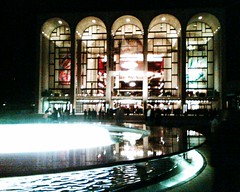
Die Zauberflöte
Metropolitan Opera
Wednesday, September 30, 2009, 8:00 pm
Conductor: Bernard Labadie
Pamina: Susanna Phillips
Queen of the Night: Erika Miklósa
Tamino: Matthias Klink
Papageno: Christopher Maltman
Speaker: David Pittsinger
Sarastro: Georg Zeppenfeld
Monostatos: Greg Fedderly
Speaker: David Pittsinger
Papagena: Kathleen Kim
Production: Julie Taymor
Set Designer: George Tsypin
Costume Designer: Julie Taymor
Lighting Designer: Donald Holder
Puppet Designers: Julie Taymor, Michael Curry
Choreographer: Mark Dendy
I totally see why this production is so popular. I didn't see an empty seat anywhere in the family circle, & was happy to settle for standing room. While there were pyramids & Egyptian motifs, the costumes looked Asian, perhaps reflecting the setting of the source fairy tale. The Queen of Night had a great costume with Peking Opera banners sprouting from her back. I was delighted with all the spectacle, especially the giant dancing bears that Tamino conjures with his flute. They more than made up for missing Siegfried's bear on a previous visit. I was highly entertained by Papageno's floating banquet, & the way that Sarastro's enemies disappear under a giant gold fabric at the end was also very effective.
The cast was uniformly fine. Christopher Maltman's Papageno is as comfortable acting as singing, & the same goes for his Papagena, Kathleen Kim, who surprised me when she finally started singing in her strong, clear voice. Erika Miklósa has an unexpectedly pleasant, almost fluffy, voice even on the highest notes. She startled me with her subito piano during a high passage in O zittre nicht. There is nothing ferocious or scary about her interpretation. Instead it's strain-free beauty impressed. Her Der Hölle Rache got the most sustained applause of the evening. Susanna Phillips as Pamina acted with her singing, & her Bie Männern duet with Papageno & Ach, Ich fühl's were musical highlights. Greg Fedderly was obviously having great fun as Monostatos, costumed as a cross between a bat & an over-weight beetle. Even the small role of the Speaker was impressively delivered by David Pittsinger.
The only thing I couldn't get excited about was Bernard Labadie's conducting, which seemed to lack structure. The singers sometimes pushed or pulled at the tempos, but to no avail. I continue to be impressed by the orchestral sound way up at the top of the house. It just takes a really long time to egress after it's all over!
The Morgan Library & Museum
The Morgan Library has long been on my list of New York tourist destinations, so I was glad to finally make it there yesterday. Renzo Piano has recently added a very contemporary atrium to join disparate buildings on the block into one structure. From a historic point of view, the most interesting things are Mr. Morgan's enormous study & library. The study, with it's dark red draperies, classical & Renaissance art, & oppressive atmosphere, looks like a set for Act II of Tosca. The library is another curious pastiche of Medieval & 19th century aesthetics.
The new acquisitions gallery reflects an eclectic approach to collecting. I saw a letter by Richardson in tiny but readable handwriting, an illustrated letter from Van Gogh to Gaugin, a disturbing drawing by Schiele, illuminated manuscripts & even a work by Andy Warhol.
They have a lot of music-related items, including a set of 4 tickets for the 1st Ring cycle at Bayreuth, color-coded for each opera. It must annoy the curators that while they have 1 ticket for each Ring opera, the 4 tickets are not all from the same cycle. I also saw samples of Bach's writing, Handel's writing (in English), as well as scores by Puccini, Leopold Mozart & Barber.
The collection also includes small religious sculptures & a set of Mesopotamian cylinder seals from over 2 millennia. These small, spool-like objects come in a variety colors & artistic styles, & they may have been my favorite objects in the museum, even though they were relegated to the lower level next to the restrooms. I also enjoyed an over-priced but quiet lunch in the atrium cafe.
The new acquisitions gallery reflects an eclectic approach to collecting. I saw a letter by Richardson in tiny but readable handwriting, an illustrated letter from Van Gogh to Gaugin, a disturbing drawing by Schiele, illuminated manuscripts & even a work by Andy Warhol.
They have a lot of music-related items, including a set of 4 tickets for the 1st Ring cycle at Bayreuth, color-coded for each opera. It must annoy the curators that while they have 1 ticket for each Ring opera, the 4 tickets are not all from the same cycle. I also saw samples of Bach's writing, Handel's writing (in English), as well as scores by Puccini, Leopold Mozart & Barber.
The collection also includes small religious sculptures & a set of Mesopotamian cylinder seals from over 2 millennia. These small, spool-like objects come in a variety colors & artistic styles, & they may have been my favorite objects in the museum, even though they were relegated to the lower level next to the restrooms. I also enjoyed an over-priced but quiet lunch in the atrium cafe.
Subscribe to:
Posts (Atom)